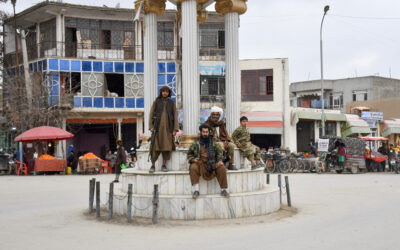
The Long Arm of China’s Security Services
SUBSCRIBER+ EXCLUSIVE REPORTING — When Chinese President Xi Jinping came to San Francisco last November to meet with President Joe Biden, Chinese pro-democracy activists in […] More
President Donald Trump put Iran on notice in October, declaring that the U.S. would counter the regime’s “destabilizing activity.”
Iran isn’t listening.
Instead, Iran is making gains throughout the region. Since October, Iranian leaders and their forces have used surrogates to launch what Ambassador Haley has just credibly argued are Iranian-made missiles against Riyadh and Abu Dhabi, played a decisive role against Iraqi Kurds in Kirkuk, and further strengthened the genocidal Syrian regime.
The result is a net win for Iran.
Meanwhile, there is an agonizing lack of action in Washington, beyond expelling hot air to criticize the 2015 agreement with the U.S. and its partners that aimed to halt Iran’s nuclear weapons program. And U.S. partners in the Persian Gulf are fighting amongst themselves instead of focusing on Iran. Because the Trump administration is taking such a hands-off approach to the region, they wind up turning more on each other—Turkey versus the Syrian Kurds, Saudi Arabia versus Qatar, Baghdad against the Iraqi Kurds—than against their common Iranian challenge.
Many have correctly analyzed the primacy of the Iranian threat, but much less is written on the reasons for the weak reaction to Iran’s regional actions. One key reason is the fear that pushing back hard would threaten the stability of the region’s many fragile states. The Trump administration, if it’s serious about countering Iran, needs to find a way to proceed and manage that instability, rather than deterring itself from real action .
Iran’s decades-long asymmetrical success in the Middle East against far stronger coalitions rests, beyond good strategic thinking and local allies, on its exploitation of that very quest for stability in a turbulent region. By routinely denying its own or surrogates’ violence, from the 1983 Beirut Marine bombing to the Riyadh missile attack, it puts the onus on the victims. If they respond aggressively against Tehran in the absence of clear-cut evidence, they risk regional turmoil.
Iran even claims that it supports stability—combating terrorists or deterring U.S. or Israeli “aggression,” for example—and that any pushback against it will rock the region.
The latest example of “stability over containment” is Saudi Arabia’s pressuring Lebanese Prime Minister Saad Hariri to resign. Leaving aside the ham-handed way this was done, the Saudis have a point: Lebanon is a power-projection platform for Iran’s surrogate Hezbollah against both the Syrian opposition and Israel. But commentators almost unanimously blamed the Saudis. As Thomas Friedman wrote in November, “Lebanon, which had forged a relatively stable balance among Sunnis, Christians and Shiites, is now shaking.” Meanwhile, Robert Malley, a former Middle East director in Obama’s White House, called for calm.
But “calm” when it serves a foe is not necessarily good. After Hezbollah provoked a conflict with Israel in 2006, the U.S. pursued “calm,” which it defined as stopping the fighting and supporting Hariri’s position, one dictated largely by Hezbollah. The result: a Hezbollah victory and, eventually, its total domination of Lebanon.
Meanwhile, the West spent billions of dollars in Lebanon rebuilding the damage that Iran’s surrogate had wrought. Colin Powell, speaking about America’s Iraq intervention, cited the “Pottery Barn Rule”—”You break it, you own it.” Iran’s winning variant is: “We break it, you fix it, then we own it.”
Iran applies this throughout the region. On Syria, the Iranians (and their Russian partners) argue that the U.S. and Europeans should pitch in now on economic reconstruction, rather than await a political solution under United Nations Security Council Resolution 2254, which sets out a road map for Syria peace talks.
While the country needs such help, a reconstructed Syria without political reforms would entrench both Syrian President Bashar al-Assad and Iran, even though they jointly created the massive instability in the region and, via the tide of refugees, in Europe, with their indiscriminate assault on civilians.
In Iraq, Baghdad also is pressing for post-ISIS reconstruction and other international support. This all makes sense. But if coupled with Iranian domination, through Iraqi political parties and militias loyal to Tehran, it is a recipe for Iranian victory over the region’s No. 2 oil exporter.
Finally, the Saudi-led campaign in Yemen against the Iran-backed Houthis is condemned, rightly, not only for military blundering, but also civilian casualties, cholera outbreaks and mass starvation. Riyadh’s explanation for the campaign—to block an Iranian surrogate bristling with long-range missiles on its borders even as Israel faces a more potent and capable missile threat from Hezbollah—is usually ignored.
The Obama administration bought this “stability first” argument, seemingly blaming conflicts on Saudi Arabia for refusing to share the region with Iran. The Trump administration, in contrast, knows that Iran is not a status quo party with whom you can share anything. Yet the U.S. appears frozen in the face of Iranian advances, with many in and out of government buying the argument for stability first. Thus the president’s “containing Iran” policy is largely left to Russia in Syria, and to Prime Minister Haider al-Abadi in Iraq.
Several factors explain this. First, our military and diplomatic leadership has long focused on stability as the key means to counter terrorism and insurgencies in the Middle East. The idea, seldom backed by results, is that provision of stability dampens enthusiasm for violence and promotes appreciation for America and its policies by local populations.
A second argument is the human cost of stopping aggression. In the 1980s, the U.S. supported conflicts in Afghanistan and southern Iraq to push back Soviet and Iranian advances, with huge casualties and eventual destabilization. The policies succeeded, but the price was high. People can debate whether they made sense, but now there isn’t even much of a debate. The quest for stability usually rolls other security priorities.
But as seen with the catastrophe in Syria under Iran’s domination with 400,000 killed, 12 million homeless and rise of ISIS, there is no stability until Iran’s expansionism is checked. Israel, the Arab states and Turkey are not going to tolerate forever a weaker Iran dominating their area, whether or not the U.S. is on board with them. That argues for the U.S. to lead the containment effort, using its winning strategy against ISIS of broad diplomatic coalitions, local allies, air support and limited U.S. ground presence.
This, however, requires managing the inevitable instability. In Syria, as Defense Secretary Jim Mattis suggests, Washington should maintain a military presence, ostensibly to deter ISIS resurgence, but also to pressure Assad, Iran and Russia to accept a political settlement.
Absent progress, Washington, the European Union and international organizations should refuse major reconstruction help. In Iraq, the U.S. should strengthen its security relationships and military presence, rebuild relations with the Kurds, and leverage U.S. and international support to encourage Baghdad to accept at least a ‘neutral’ role between the U.S. and Iran.
Along with the military tension between the U.S. and Iran and the exploitation of sectarian divides, and with no immediate end state in sight, an approach of delaying reconstruction admittedly risks volatility. But failing to act against Iranian expansion risks far greater instability, with Syria’s current civil war the prime example.
And with such a program, the U.S. could credibly negotiate with Russia—and eventually with Iran—for a regional resolution. Success containing Iran also would help the U.S. persuade Israel, Turkey and Saudi Arabia to relinquish their go-it-alone forays that only exacerbate instability for little result, and better coordinate on joint actions with Washington.
Related Articles

SUBSCRIBER+ EXCLUSIVE REPORTING — When Chinese President Xi Jinping came to San Francisco last November to meet with President Joe Biden, Chinese pro-democracy activists in […] More

SUBSCRIBER+EXCLUSIVE EXPERT PERSPECTIVE — More than two years after its withdrawal from Afghanistan, the U.S. still does not have a clear way forward in the […] More

SUBSCRIBER+ EXCLUSIVE REPORTING — Ukrainians greeted Saturday’s long-awaited House passage of $60.8 billion in aid with justifiable jubilation. For months, their soldiers, civilians, and political […] More

SUBSCRIBER+ EXCLUSIVE REPORTING — A race for control of space is underway, and just as on earth, the U.S. and China are the top competitors. […] More

SUBSCRIBER+ EXCLUSIVE REPORTING — For nearly a week, the Middle East and much of the world were on a knife’s edge, waiting for a promised […] More

BOTTOM LINE UP FRONT – Less than one week after Iran’s attack against Israel, Israel struck Iran early on Friday, hitting a military air base […] More
Search